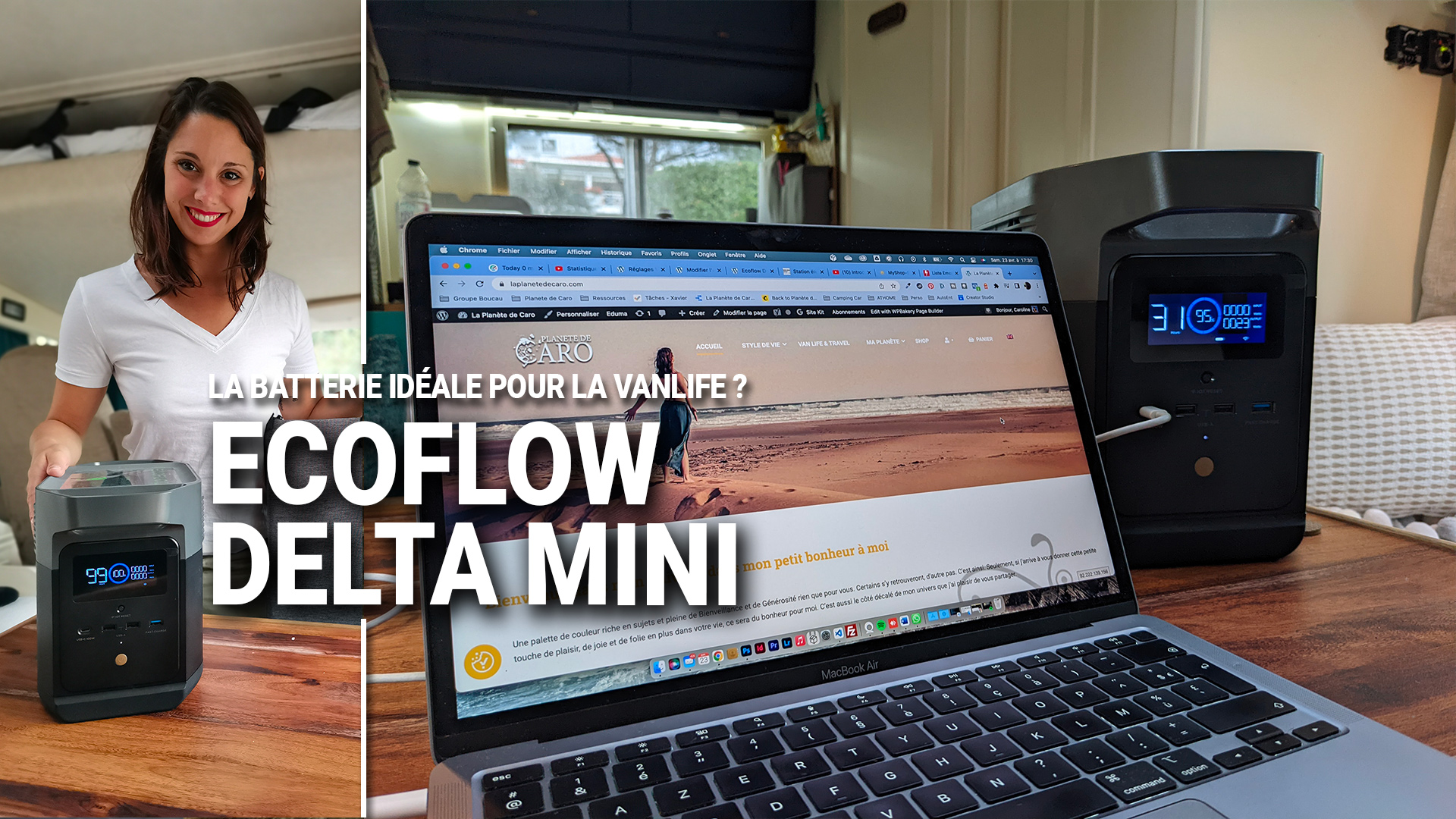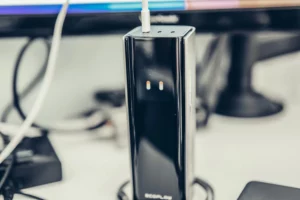
Ecoflow Delta Mini: Battery and 110W solar panel test
Introduction
When it came to choosing the electrical system for our motorhome, we had a choice of two technologies.
The other choice is the battery that integrates all these devices, in plug & play mode, and that’s all there is to it.
We had opted for the first option, but Ecoflow recently suggested we test the second solution with the Delta Mini battery. And it’s fair to say that if we’d known, we might not have bothered so much the first time!
Here’s a short article on this little beast’s techno-package, its advantages and disadvantages.
Overview of our current installation

For those of you who remember, we opted for a fairly standard installation consisting of 3 solar panels of 150 Watts each mounted on tilting supports to recover at least 30% extra energy when the sun is lower in the year.
All this was connected to the charge controller, which in turn was connected to the battery.
We recharged our electrical appliances thanks to the 900W peak converter connected to this same 120Ah battery, which also recharged the battery (it’s a charger/converter) when we were at a campsite or service area with a 220v socket.
When we were on the road, we added another module to recharge our 120Ah battery while driving.
Finally, all this could be controlled from the phone or from a screen in our control panel.
All that was missing was a control panel with cigarette lighter, USB 2.0 and USB C outputs, plus a fuse to protect the entire installation.
In the end, there are no fewer than 8 different products (excluding solar panels) to install for our daily energy needs.
✅ The Ecoflow battery integrates all these modules in a single product!
Since the release of this article, Ecoflow has developed two new products, the Ecoflow Power Kit Energy, a more sedentary product designed for both Van, but also isolated homes, and an incredible self-contained cooler fridge.
Ecoflow Delta: Mini by name Maxi by performance
WhenEcoflow suggested we test their equipment, it had been a year since we had been able to test our own installation, which was perfect 98% of the time. We were able to be virtually self-sufficient all year round, but we had to be vigilant in our energy management.
The initial calculation problem was that we could recharge our battery completely in 1 hour of sunshine. Basically, we were good energy producers, but when it came to storage, we lacked a bit of capacity, and sometimes a few days of clouds were enough to stress us out a bit. So in the southern regions it was fine, but as the rest of the journey takes us into northern Europe with more cloud cover, we need to boost this. So we opted for a Delta Mini, a fairly compact version with plenty of power. We asked to add their 110W folding solar panel, as we had in mind to be able to do streams totally outdoors, in original locations.
A few days after ordering, we received our equipment. And we were intrigued to see what the little beast was up to.
Technical specifications
The model we have chosen is the Delta Mini. It weighs 11 kilos, and measures 37.0 × 18.3 × 23.6 cm, roughly equivalent to two shoeboxes. It has a capacity of 882Wh and a power output of 1440W, which can reach 2200W in turbo mode. I remind you that my converter charger had a peak power of 900W.
You can power up to 9 devices via the various outputs, including a 100W USB-C socket. To recharge, it takes 1.6 hours from an electrical socket, 9.5 hours from the cigarette-lighter socket, 3.3 to 6.6 hours with 3 x 110 W solar panels, 3.7 to 7.4 hours with 2 x 160 W solar panels.
It features numerous safety features, including protection against overvoltage, overload, overtemperature, short-circuit, low temperature, low voltage and overcurrent.
Unpacking and first impressions

When you first discover this Ecoflow battery, you immediately realize that you’re dealing with quality material, and that the company’s engineers have done their homework. For your information, ecoflow batteries have long been used in DJI drones… Yes, it’s a small world!
The 11 kilos are easy to handle thanks to the two integrated handles, which allow it to be held with one hand, two hands or two people.
A quick glance at the connectors reveals that thefront panel is equipped with USB (1x USB-C 100W, 2x USB-1, 1x USB FastCharge), while the rear panel features two 2x 220V sockets and a 12V female cigarette lighter, which can be activated by a button. If these buttons are not pressed, the plug cannot be activated.
Above these sockets a

hatch for recharging your mobile battery. A box is supplied with the battery, including instructions and the various cables needed to recharge it: a 220v cable, a 12v male cigarette lighter cable and an MC4 cable for solar panel recharging.
Daily test
On a day-to-day basis, this battery already makes us more comfortable when we’re working.
Housed under the table, it eliminates the need to run electrical cables across the camper’s driveway. (our electrical outlets being on the opposite side from where we were working). When our electrical appliances were plugged in, we had to step over the cables, and we had to be precise not to put everything on the floor. (especially in the mornings lol).
It’s a detail that mainly concerns our layout, but other vanlifeurs are not immune to the same worries.
It also makes it easier for us to work outdoors.
- Next to our Edouard (our CC): we no longer have to pull our extension cords through the camper van, or climb through an open window. And what a paradox it is to have screens on the windows, only to have to leave them open to let a cable through! So we can work quickly and easily in the sunshine.
- Away from our Edouard: this battery gives us the opportunity to connect our 12V modem to the cigarette lighter socketbut also our two computers and further explore teleworking in remote areasIn restaurants, with subscribers who have a poorer ADSL connection than our 4G connection.
The front panel display is perfect for keeping track of consumption, charge level and remaining operating time. Under test conditions, my MacBook Air M1 can be powered and therefore recharged via the USB-C port for 30 hours, during which time it also recharges. As this laptop has a good battery life, I don‘t imagineyou’ll have any trouble lasting a week with a full battery, if you manage the MacBook’s discharges and recharges well (in surfing and word-processing conditions). I find it impressive.

Two of us are sometimes plugged in to the 220V sockets when we’re working, so we have no problem powering our two computers.
At last, we can plug in powerful appliances! Yes, ladies and gentlemen, a hairdryer or even a drill, this battery is capable of powering appliances that our current installation couldn’t, and for half the price.
The refill
We tested all 3 types of recharge. With our electrical installation, which is not that of a home, it takes us around 4 hours to complete a full charge, which is 3 times longer than what is given in the technical specifications, but then again our installation is not that of a home :).
On a day-to-day basis, we should be able to recharge both our cell battery and the Ecoflow battery in good weather.
With the solar panel, we were able to produce between 60 and 70Watts, but we didn’t manage to reach the 110W peak, which is normal in springtime, I’d say. But 60 and 70 watts enough to power our two MacBook Air M1s and keep some to recharge the Delta Mini. (not much, but recharge the battery anyway).
Last but not least, we tested out the cigar lighter charging system, which could come in handy if we’re really unlucky with the weather and have to drive. Normally, with our system, it’s better to use our own solar panels or Ecoflow panels. On the other hand, it’s really great for everyone who owns a car. Choose a River model, and you’re all set for weekends in the tent, with enough power for your appliances and lights, and recharging via your car’s cigarette lighter socket. It’s really the best.
Wifi connectivity

Wifi connectivity on a battery? But what for? With the Ecoflow application on your phone or tablet, you can get battery information directly on your device. If we’re in a camper van, access is pretty quick, but in a house, it can be interesting to know where you are with your recharge.
I confess I had a bit of trouble connecting to it, and I’ll explain why:
You can connect directly to it, or have the battery connect to your modem router, so you can access it from anywhere. However, the battery doesn’t seem to be able to connect to a 5Ghz Wifi network, which is my case. Our modem has two networks, one in 2.4Ghz and the other in 5Ghz. So I tested the 2.4Ghz connection, which worked straight away. This enabled the battery to connect to the net and send information to Ecoflow. I can now access these directly from my phone (when the battery is on or on standby).
Positives and negatives after 2 weeks of testing
Aesthetically pleasing, easily transportable despite its 11 kilos, integrating all the modules of a normal installation, accepting 3 types of recharge, offering multiple outputs.
It really is perfect for those who want a reliable, highly mobile and easy installation.
I’ll note two negative points about our use: it incorporates fans that can sometimes start up to cool the system, and we weren’t used to this with our totally silent installation. During an early afternoon siesta, when it’s optimal to recharge the Ecoflow Delta Mini on our network, the fact that the fans come on is a bit of a shame. The second negative point was explained above, and may be a setting problem for me, human: the non-existent Wifi connection in 5Ghz. So far, 2 weeks of use. If I find any other problems, I’ll let you know.
Conclusion, Reviews and Discount Coupon Code Delta Mini Ecoflow
Overall, this battery is a success. It calls my installation into question, and I say to myself that maybe I should have chosen an all-in-one solution of this type rather than numerous small devices. This would have enabled us to have both a fixed and a mobile battery. My installation cost me just under 3500€ including solar panels and with a very good offer at the time.
An Ecoflow DeltaMax battery and a 400W solar panel are under 3000€, much easier to set up, more powerful, and easy to move.
Does that make it the ultimate product? So if you’re not in a 24-hour CC like us, yes, of course. A Delta that can be taken home and plugged into the motorhome or van, this product is ideal.
In our case, where our CC is our home, it’s no bad thing to have a custom installation where our USB outputs are where we want them, and silent. But having a Delta Mini as a backup with a custom installation is a luxury not to be underestimated. In any case, we can only urge you to have this type of battery in your vehicle as well.
And if you use our coupon code, you’ll also get a nice 5% discount on the entire Ecoflow site.
If you’re looking for energy peace of mind, don’t hesitate!



